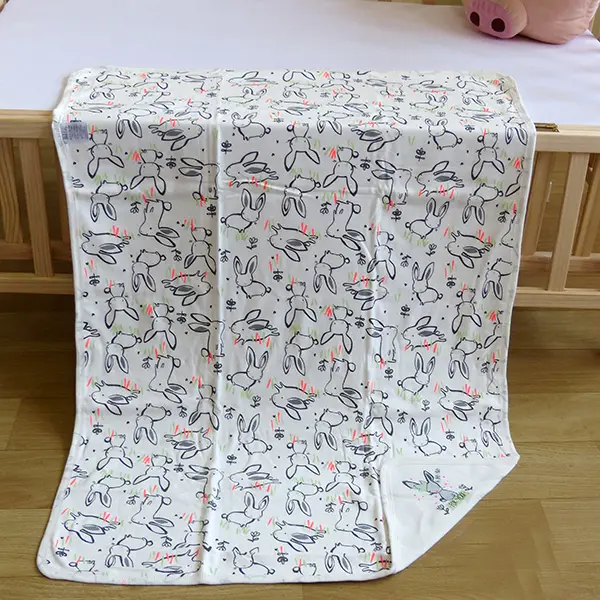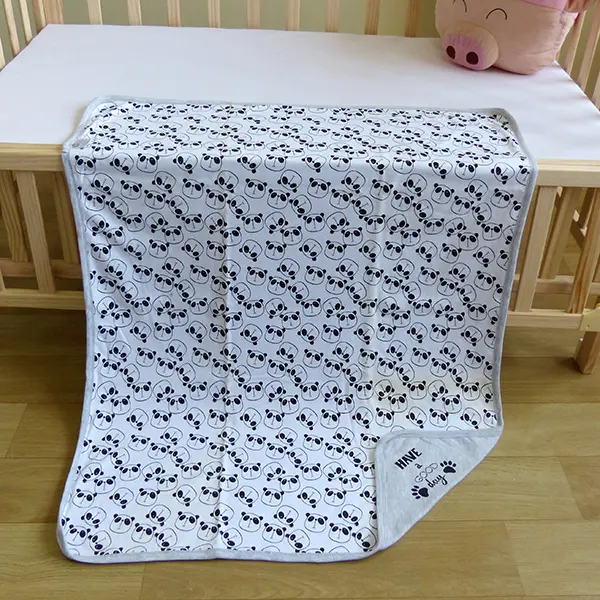Interlock Swaddle: Breathable Organic Cotton for Newborns?
Why the interlock swaddle is having a moment (and what to know before you buy)
I’ve been covering baby textiles long enough to see fabrics come and go, but when I first handled an interlock swaddle, I knew the trend wasn’t hype. Interlock knits have that double-faced, naturally stretchy handfeel that parents keep describing as “cloudy-soft.” This specific product—100% cotton baby double layer blanket made of interlock fabric—comes from Shijiazhuang, Hebei, China (Room 1106-1108 Zhongyuan Building, No.368 North Youyi Street). It’s two layers: one allover print, one solid with a neat offset print. Simple idea, surprisingly refined execution.

Market pulse
Parents want breathable, OEKO-TEX-certified fabrics, traceable supply chains, and prints that don’t scream “nursery aisle.” Interlock checks those boxes: stable, pill-resistant, and durable. Retailers tell me reorder rates are steady because, to be honest, gifting drives half the category.
Technical snapshot
| Base fabric | 100% cotton interlock, double layer |
| Overall weight | ≈ 320–380 gsm (real-world lots may vary) |
| Typical size | 80 × 100 cm (customizable) |
| Printing | One side allover; reverse with offset motif |
| Edge | Overlock/coverstitch, rounded corners optional |
| Compliance | OEKO-TEX Standard 100; CPSIA lead/phthalate requirements |
| Service life | ≈ 2–3 years household use if laundered per care label |
How it’s made (quick process flow)
Materials: ring-spun combed cotton yarn → interlock knitting (balanced, two-needle bed) → pre-shrink & softening → pigment or reactive printing (low-AZO) → cutting → layered assembly → coverstitch hemming → 4-point inspection → packing. Testing typically includes AATCC 61 colorfastness to laundering (Grade 4–5 reported), AATCC 16 light fastness (Grade 4), ASTM D4966 Martindale abrasion (≥15,000 cycles), and ASTM D5034 grab tensile checks. Some buyers ask for ASTM F1917 guidance for infant bedding performance specs.

Where it shines
- Everyday wrap: the stretch of interlock swaddle helps a snug, comfy wrap without Velcro fuss.
- Stroller and car-seat drape: breathable, cozy in AC or breezy evenings.
- Tummy time and play mat layer: soft, double-layer cushioning.
- Nursing cover or burp cloth stand-in: parents improvise; this fabric cooperates.
Note: follow current safe sleep guidance; avoid loose bedding in unattended sleep environments.
Why interlock, specifically?
Compared with jersey, the double-knit structure resists twisting, keeps its shape, and feels plusher against newborn skin. Many customers say the interlock swaddle survives weekly washes with fewer pills than flannel alternatives.
Vendor snapshot (real-world buyer concerns)
| Vendor | Certs | MOQ | Lead time | Customization |
|---|---|---|---|---|
| ST Home Textile (Hebei) | OEKO-TEX, CPSIA docs | ≈ 500–1,000 units | 25–35 days | Print, size, GSM, packaging |
| Vendor A (Mass-market) | OEKO-TEX | ≥ 2,000 units | 45–60 days | Limited SKUs |
| Vendor B (Boutique) | Small-batch tests | ≈ 200–300 units | 30–40 days | Art-driven prints |
Customization and branding
Options include 75×100 or 90×110 cm, GSM tuning for climates, reactive versus pigment inks, private-label belly bands, recycled poly mailers, and gift box sets. Buyers sometimes request QR traceability for yarn-to-box transparency—feels niche, but it’s growing.

Quick case notes
- Nordic boutique chain switched to interlock swaddle; returns dropped below 0.6% and they extended the line into seasonal prints.
- Regional maternity gift program used custom pastel solids; post-campaign survey showed 87% “very satisfied,” mainly praising softness after multiple washes.
Care, durability, and real test data
Wash cold, gentle cycle, tumble low. Internal lab data (buyer shared) showed pilling grade 4.5 after 10 washes (ASTM D4970), and dimensional change within −3% after home laundering. That tracks with what I’ve seen in-store samples.
Certifications and standards to ask for
OEKO-TEX Standard 100 for harmful substances; CPSIA tracking labels; ISO 9001 quality management at the mill; test reports referencing AATCC and ASTM methods. If you sell bedding sets, align with ASTM F1917 guidance.
Citations
- OEKO-TEX Standard 100: Product Class I criteria for babies. https://www.oeko-tex.com
- ASTM F1917: Standard Consumer Safety Performance Specification for Infant Bedding. https://www.astm.org
- AATCC 61/16 Colorfastness Test Methods. https://www.aatcc.org
- ASTM D4966/D5034/D4970 Textile Performance Methods. https://www.astm.org
- CPSIA Requirements for Children’s Products. https://www.cpsc.gov
-
OEM Rectangle Table Cloth: Custom Quality & Sustainable Solutions for Global BrandsNewsNov.24,2025
-
OEM Adult Bedding Set – Customized Quality Bedding Solutions for Healthcare, Hospitality & ReliefNewsNov.24,2025
-
OEM Summer Baby Garments – Quality, Comfort & Global SolutionsNewsNov.23,2025
-
OEM Solid Color Polyester Table Cloth – Durable, Customizable & Sustainable Textile SolutionsNewsNov.23,2025
-
OEM Baby Towels: Quality Manufacturing for Global Baby Care BrandsNewsNov.23,2025
-
OEM Woven Cotton 7pcs Crib Bedding Sets – Safe, Sustainable & Customized Baby Bedding SolutionsNewsNov.22,2025
- Product Categories
- • Hospital Used Fire Retardant Bedding
- • Hotel Textiles
- • Airline Textiles
- • Hometextiles
- • Infant Cloth
- Quick Links
- • Home
- • Products
- • About us
- • News
- • Contact
- Contact Us
-
Tel: +8631187701449
-
Fax: +86 311 8770 1444
-
E-mail: sale@hometex-suntex.com




